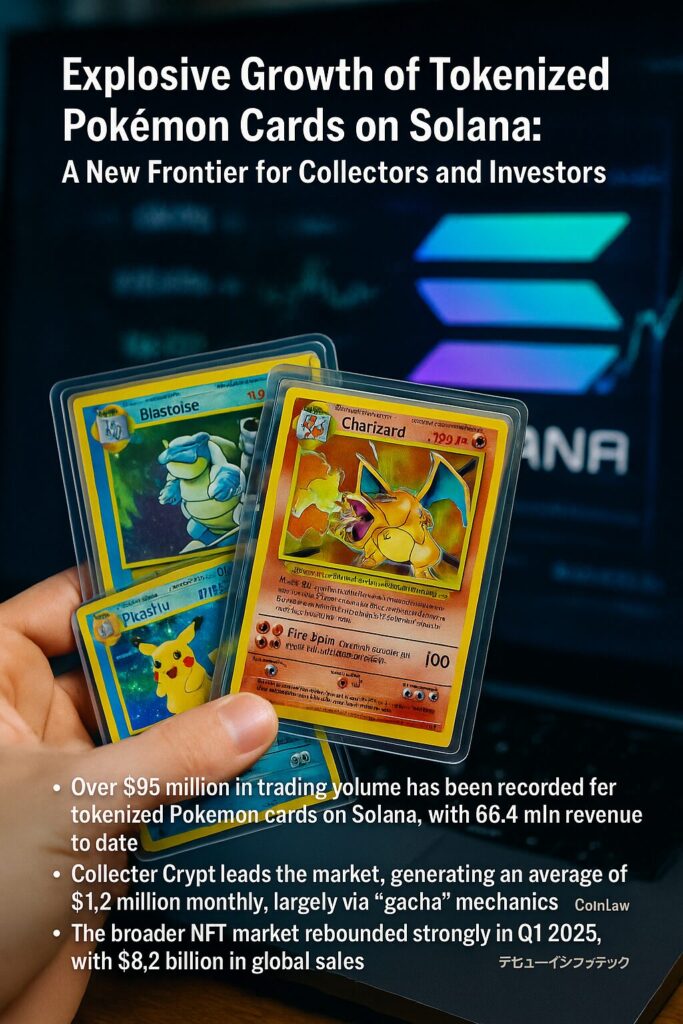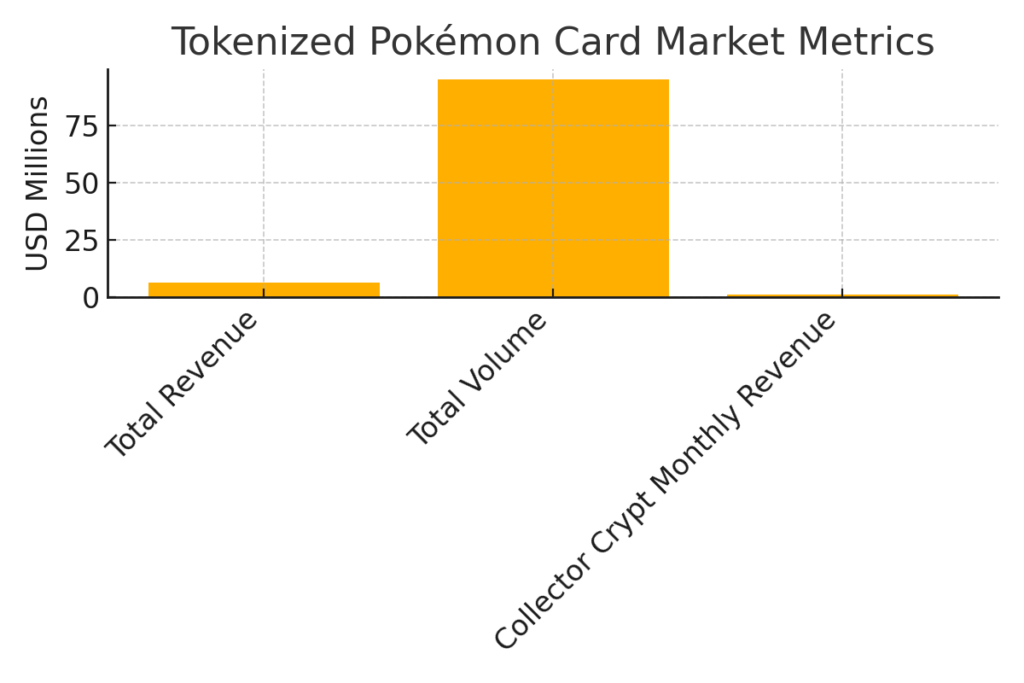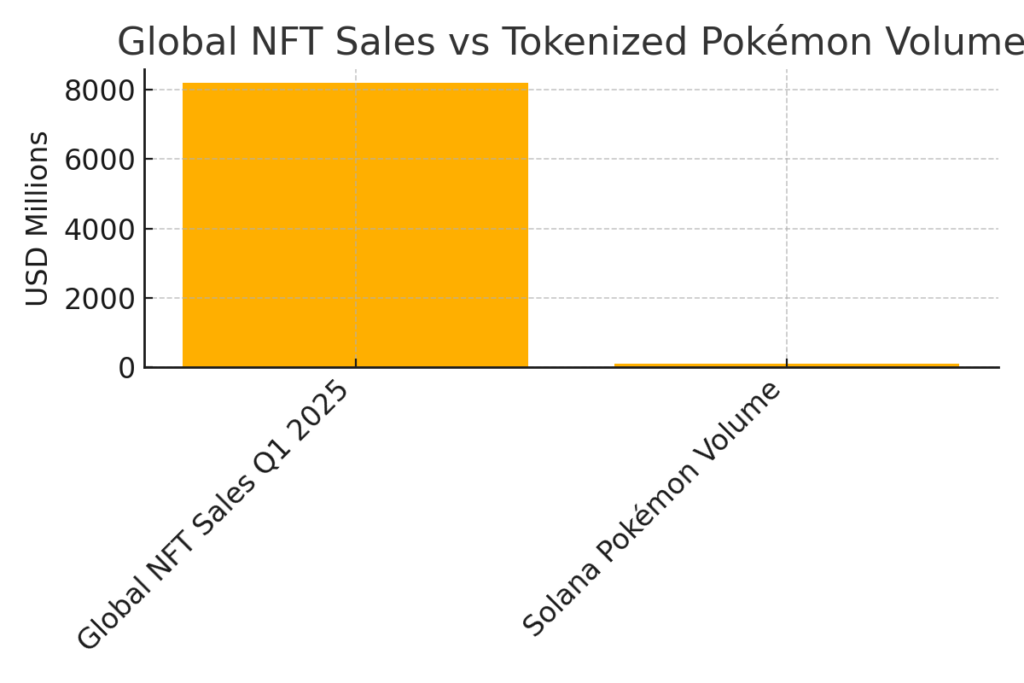
Main Points:
- Over $95 million in trading volume has been recorded for tokenized Pokémon cards on Solana, with $6.4 million in revenue to date.
- Collector Crypt leads the market, generating an average of $1.2 million monthly, largely via “gacha” mechanics.
- The broader NFT market rebounded strongly in Q1 2025, with $8.2 billion in global sales.
- Asset tokenization is booming, projected to reach $2.08 trillion in 2025.
- Tokenized collectibles address liquidity and fraud issues in traditional markets but carry legal and security risks.
1. Introduction: Pokémon Cards Meet Blockchain
The Solana blockchain’s low fees and high throughput have enabled the rapid emergence of a thriving secondary market for tokenized Pokémon cards. By representing physical cards as NFTs, collectors gain fractional ownership, instant liquidity, and programmability—features unheard of in the traditional trading‑card landscape. This convergence of tangible collectibles with blockchain technology has attracted both hobbyists and institutional players seeking new revenue streams and practical DeFi integrations.
2. Market Metrics and Leaders
Total Volume and Revenue
To date, tokenized Pokémon cards on Solana have amassed over $95 million in trading volume, generating $6.4 million in platform revenue.
Market Leader: Collector Crypt
Collector Crypt, the pioneering trading-card tokenization platform, accounts for an average of $1.2 million in monthly revenue—driven primarily by its gacha mechanism, where users spend an average of $16,500 each across 3,004 unique wallets.
[Insert Figure 1: Comparative Revenues and Volumes of Tokenized Pokémon Card Market]

3. Gacha Mechanics: The Engine of Growth
Gacha—a randomized “capsule toy” system—powers much of the spending. Users draw tokenized cards of varying rarity; the platform immediately offers to buy back cards at 80–85% of their market value, encouraging further plays. Across all platforms, gacha purchases exceed $50 million, underscoring its central role in driving revenues.
4. High‑Value Sales and Collectible Highlights
Record sales on emerging platforms illustrate the market’s enthusiasm:
- On TCG Emporium, a “Mario‑costumed Pikachu” NFT sold for $11,300 ($165 ×10³).
- On Collector Crypt, a “Poncho‑wearing Pikachu” NFT fetched $9,300 ($136 ×10³).
These figures echo the premium paid at physical card auctions: a Japanese Pokémon card sold for ¥50 million (~$330 ×10³) in New York late in 2024.
5. Context: NFT Market Rebound and Asset Tokenization Trends
Global NFT Sales
After a downturn in 2024, NFTs surged in Q1 2025 with $8.2 billion in sales, marking a renewed institutional interest and utility‑driven adoption.
[Insert Figure 2: Global NFT Sales vs Tokenized Pokémon Volume]

Asset Tokenization Growth
Beyond digital art, real‑world asset tokenization is on track for a $2.08 trillion market in 2025, offering pathways for fractional ownership of everything from real estate to collectibles.
6. Benefits and Risks
Liquidity and Transparency
Tokenization dissolves the liquidity fragmentation of Web2 markets, enabling 24/7 trading and transparent provenance. Smart‑contract buy‑back features further stabilize secondary prices.
Legal and Security Concerns
However, most tokenized Pokémon cards lack official licensing from Nintendo or The Pokémon Company, exposing platforms and users to potential intellectual‑property disputes. Unregulated marketplaces also carry heightened counterparty and smart‑contract risks.
7. Practical Use Cases for Collectors and Investors
- Fractional Ownership: High‑value cards become accessible via fractional NFT shares.
- Programmable Rewards: Smart contracts can automate royalty splits for creators and charity donations.
- DeFi Integration: NFT collateralization in lending markets opens new financing avenues.
8. Outlook: Next Steps for the Ecosystem
The intersection of physical collectibles and blockchain promises further innovation—expect more sophisticated gacha models, cross‑chain interoperability, and compliance frameworks to emerge. Partnerships with established brands could legitimize tokenized cards, while decentralized identity solutions may streamline KYC and provenance checks.
Conclusion
The Solana‑based tokenized Pokémon card market exemplifies how blockchain can revolutionize physical collectibles, blending liquidity, transparency, and financial innovation. While nascent, its rapid growth—driven by gacha mechanics and high‑value sales—aligns with broader NFT and asset‑tokenization trends. For collectors and investors alike, this sector offers both new revenue potential and practical use cases in DeFi, albeit with legal and security considerations that must be navigated carefully.

